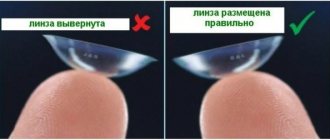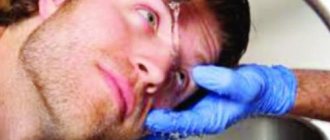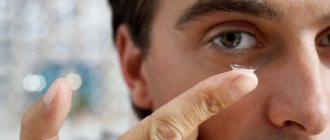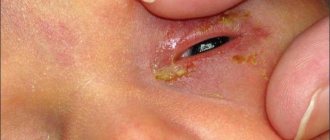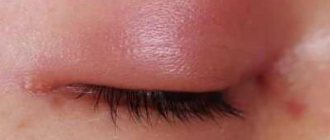Colds, flu and any other seasonal illness forces us to make changes to our usual routine. One way or another, the rhythm of life slows down. You need to listen to your body and, of course, follow the recommendations of your doctor. And also - wrap yourself in the softest blanket and slowly drink the most delicious tea. But it is also worth remembering that on the path to recovery you will have to give up some everyday things. For example, limit meetings with family and colleagues, and avoid excessive physical activity. But for those who wear soft contact lenses (SCL), it is better to replace them with glasses during their illness.
How does ARVI affect eye health in contact lenses and what to do if you get sick and don’t have glasses at hand? Read on about this!
Contraindications for the visual organs
First of all, contraindications for lenses are diseases and defects of the visual organs.
Inflammatory diseases
The following is an incomplete list of inflammatory diseases for which wearing contact lenses is contraindicated. After treatment and complete recovery, which will be confirmed by an ophthalmologist, the patient will be able to return to contact vision correction.
So, you will have to temporarily abandon the lenses if the inflammation affects:
- Eyelid margins – blepharitis;
- The mucous membrane of the eye – conjunctivitis;
- Lacrimal sac – dacryocystitis;
- The choroid of the eye – uveitis;
- Sclera – scleritis;
- Cornea – keratitis;
- Anterior segment of the eye – iridocyclitis.
What happens if you use contact lenses while sick? Inflammatory processes can worsen due to lack of oxygen and mechanical irritation of the mucous membrane, and under the lens, especially without proper care, a favorable environment is created for the growth and development of bacteria. This can lead to the fact that the acute form of the disease becomes chronic or severe complications arise, the treatment of which will require surgical intervention.
Inflammatory diseases are a temporary but strict contraindication to wearing contact lenses
If the disease has already become chronic, it is not recommended to use contact lenses during periods of exacerbation. As for wearing lenses during periods of remission, when there are no obvious manifestations of the disease, the decision remains with the ophthalmologist - each such case requires an individual approach.
Visual impairment and non-inflammatory diseases
Separately, we should highlight a number of conditions of the visual system that are not strict contraindications to wearing contact lenses, but require an integrated approach from an ophthalmologist.
- Strabismus, but provided that the deviation angle is 15 degrees or more. If the deviation angle is less, the use of contact lenses is permissible, but only after consulting an ophthalmologist - the doctor will evaluate the condition of the eyes and make a final decision;
- Chronic dryness;
- Lens subluxation;
- Ptosis of the eyelid;
- Violation of the composition of the tear fluid.
Sign up for a free selection of contact lenses
In these conditions, the ophthalmologist not only determines the possibility of wearing contact lenses, but also prescribes appropriate treatment. The patient is offered additional measures to ensure comfort when wearing lenses, if it is possible to select them. For example, this could be surgical treatment.
Contraindications for the use of contact lenses
Description
The main medical contraindications to the prescription of contact lenses for vision correction are inflammatory diseases of the anterior segment of the eye. These include recurrent keratitis (for example, herpetic), scleritis, uveitis, in which mechanical irritation and hypoxia caused by wearing lenses can aggravate the disease.
For acute inflammatory diseases
(conjunctivitis, keratitis, barley, etc.) wearing contact lenses is stopped until cure. In chronic processes, contraindications to contact correction should be considered relative. Particular attention should be paid to such a very common disease as marginal blepharitis. More often observed is the so-called anterior blepharitis, which is classified into staphylococcal and seborrheic.
The first type of blepharitis is caused by staphylococcus; Chronic inflammation of the hair follicle, epidermal ulcerations, and tissue destruction develop. In the second type of blepharitis, the glands of Zeiss and Moll are affected. At the same time, yellowish sebaceous scales are observed along the edge of the eyelashes after removal of which, unlike staphylococcal blepharitis, no ulceration is observed. The clinical picture and complaints of patients with both types of marginal blepharitis are very similar - itching, burning in the eyes, foreign body sensation, slight photophobia, dry eyes, hyperemia of the eyelid margins. Secondary complications often occur - chronic conjunctivitis, point corneal epitheliopathy. The course of the disease is chronic, accompanied by exacerbations and remissions. Treatment: for staphylococcal blepharitis - local antibiotics, cleansing the edges of the eyelids using special wipes (for example, Ocusoft), artificial tears. Posterior marginal blepharitis is caused by inflammation of the meibomian glands, has a similar clinical picture, and also occurs chronically with exacerbations and remissions. Treatment is massage of the meibomian glands, local antibiotics.
Parasitic diseases of eyelashes have become very widespread
caused mainly
by Demodex mites
. Thus, in the USA, this pathology was found in 58% of the population aged 26 to 50 years and in 67% of the population aged 51 to 90 years (Efron N., 1998). Various types of mites are localized in the hair follicles of the eyelashes or the glands of Zeiss and Moll. The clinical picture of the disease caused by these parasites is similar to anterior marginal blepharitis. The course is often subclinical, chronic with exacerbations, although severe forms of the disease also occur. Treatment consists of removing mites as much as possible mechanically (special scrub systems, wipes soaked in ether, etc.) followed by rubbing in ointments (for example, yellow mercury).
For these diseases, wearing contact lenses if they are tolerated satisfactorily is not contraindicated, but in case of exacerbations, wearing lenses is stopped for the duration of treatment, which usually lasts 2-3 weeks.
Particular attention should be paid to patients with microsymptoms of “dry” eyes,
which are often diagnosed as chronic conjunctivitis. In these conditions, as mentioned above, lens intolerance may occur due to disruption of the stability of the tear film. Therefore, in cases of intolerance to contact lenses, the condition of the lacrimal apparatus and tear fluid (tear production, time of tear film rupture, etc.), meibomian glands should be especially carefully examined and, if necessary, appropriate treatment should be carried out. For blepharitis and microsymptoms of “dry” eyes, more frequent cleaning and disinfection of lenses or the use of one-day lenses, highly hydrophilic SCLs, and artificial tears are recommended.
Particular attention should be paid to chlamydial conjunctivitis (paratrachoma)
, which have recently become widespread, especially among young people. Chlamydial conjunctivitis accounts for 10 to 14% of all conjunctivitis. The duration of the disease in case of untimely diagnosis and ineffective treatment can reach 3-6 months. Chlamydial conjunctivitis is associated with urogenital chlamydial infection, which is often asymptomatic.
The transfer of pathogens is carried out by contaminated hands from the infected genitourinary organs of the patient
. Limiting the possibility of autoinfection, i.e. transfer of infection from a diseased eye to a healthy one confirms that the disease mainly affects one eye. Less commonly, the pathogen enters the eye with water from stagnant waters (swimming pools). Typically, chlamydial conjunctivitis is diagnosed very late, after 2-3 months of unsuccessful treatment for allergic or viral conjunctivitis.
How to get rid of glasses, contacts and health problems forever. How to learn to see 100%? Michael Richardson will teach you this and much more with the “Seeing Without Glasses” program, which will teach you how to manage the Natural Health Functions of the Body and help you regain lost health and vision. Click here to get rid of diseases forever.
The clinical picture of these conjunctivitis is expressed in severe hyperemia and pronounced swelling of the eyelids, narrowing of the palpebral fissure, and pseudoptosis. Typical for paratrachoma are large, loose follicles located in rows in the lower fornix, which later merge in the form of 2-3 ridges. The discharge is insignificant, mucopurulent in nature. Subsequently, damage to the upper limbus occurs (hyperemia, swelling, vascularization) in the form of micropannus, and multiple pinpoint subepithelial infiltrates, similar to adenovirus infection, appear on the cornea. As the disease progresses, the pannus becomes more pronounced and spreads to 1/3 of the cornea. On the cornea in the limbal region, gray infiltrates of a round shape and superficial ingrowth of blood vessels into the limbal region are observed.
Characteristic of paratrachoma
is the appearance from 3-5 days of the disease of regional pre-auricular adenopathy on the side of the affected eye, enlargement of the lymph nodes, painful on palpation, decreased hearing on the side of the affected eye.
There is no ideal laboratory diagnostic test for eye infections. It is recommended, for example, direct examination from smears or scrapings - cytoplasmic immunofluorescence or enzyme immunoassay.
The currently recommended treatment method
, including a 10-day course of maxaquin (lomefloxacin) 1 tablet (400 mg) once a day in combination with one of the local therapy drugs. The following drugs are used locally: Eubetal ointment - 4-5 times a day; Colbiocin ointment - 4-5 times a day; 0.3% Okacin eye drops (lomefloxacin) - 5-6 times a day. If the dynamics are positive during the treatment, the number of instillations of drops or ointment applications decreases every subsequent week.
Using eye drops
It is advisable to combine Okacin or Colbiocin ointments with anti-inflammatory therapy: starting from the second week, add instillations of dexamethasone eye drops for 1 week, 1 time per day, subsequently - 2 times per day.
It is recommended to prescribe SCL 6 months after complete cure.
For recurrent iritis and iridocyclitis, the issue of using corrective contact lenses is decided individually after a trial wearing of the lens, and also depending on the frequency of relapses, the clinical picture of the disease and other factors.
Lenses are contraindicated
with obstruction of the lacrimal ducts, dacryocystitis. In these cases, preliminary therapeutic or surgical treatment is recommended.
In the presence of pterygium or pinguecula, the selection of contact lenses is difficult due to the fact that these formations are a mechanical obstacle to the movement of the lens. Surgical treatment is recommended.
For corneal dystrophies, SCLs are usually prescribed, but the issue of tolerability of the lenses is finally decided after a trial wearing them.
Of the common diseases, mental illnesses are contraindications to the use of contact lenses.
It should be noted that poor tolerability of lenses can be observed in patients with diabetes, during pregnancy, menstruation, and menopause (dry eye syndrome); The tolerance of lenses in hot climates and dusty atmosphere deteriorates.
Failure to comply with hygiene rules when using contact lenses
can also lead to complications. It should be noted that refusal of contact lenses and their poor tolerability are often observed with insufficient motivation to use contact lenses for vision correction.
—
Article from the book: Contact vision correction | Kivaev A.A., Shapiro E.I.
How to protect your eyes if you get the flu or ARVI
Complications after a cold, flu, acute respiratory viral infections, acute respiratory infections - who among us has not encountered these diseases? Getting sick is always unpleasant, you want to get better quickly, and those who wear contact lenses should be especially careful during illness. Wearing lenses during this period is contraindicated or you need to take temporary measures to protect your eyes.
Everyone is well aware of the symptoms of the disease: runny nose, cough, frequent sneezing, itching in the nose and eyes. At the same time, many bacteria and viruses spread around the eyes, which are found in the mucus from the nose, in the smallest droplets of saliva when sneezing. Many of them easily settle on contact lenses, on the eyes, and also enter the conjunctiva through the lacrimal canal, causing severe irritation. Our eyes either dry out or, on the contrary, water, but we want to scratch them anyway, and this leads to additional proliferation of bacteria. Here are some recommendations from doctors on what to do if you wear contact lenses and contract a viral disease. You should adhere to them to avoid unpleasant consequences for vision in the future:
- Consult an ophthalmologist about the medications your therapist will prescribe. Some antiviral medications can cause the cornea to dry out and the lens to rub, causing discomfort;
- During your illness, it is better for you to stop using contact lenses altogether. During this period, it is worth using glasses that can be washed at least every five minutes, or daily lenses, and putting on a new pair every day, which eliminates the possibility of viruses and bacteria accumulating on them;
- As a means of additional protection, you can use a medical mask. It will protect you from your own bacteria from the nose and mouth;
- try to be in crowded places less, especially during periods of mass epidemics in spring and autumn, when there is an increased risk of contracting an infection. You may not immediately detect the disease, but the virus will already cause harmful effects to your eyes;
- Doctors do not advise wearing lenses during seasonal allergies. For example, if you have an allergic reaction to birch blossoms in the spring, it is also better not to use lenses at this time. Constantly watery eyes, sneezing and a stuffy nose pose a danger to contact correction products and to the eyes themselves.
After complete recovery, it is still better to carry out preventive enzyme cleaning of lenses and visit an ophthalmologist for a vision test. Bacteria that enter the cornea can cause severe inflammation and lead to vision impairment.
How do night lenses work?
Before answering the question why night lenses should not be worn during illness, it is necessary to understand the effect they have on the eyes. The main mechanical impact of orthokeratology occurs on the ocular cornea. The lens affects it in such a way that it restores vision to 100% for a certain period of time.
Due to increased rigidity and good gas permeability, night lenses are practically safe for the eyeball and therefore can be used during sleep for 7 to 9 hours.
Only an ophthalmologist can select a lens model. He will also talk about the features and rules of wearing them, and explain why you should not wear night lenses during illness. If you do not follow the last rule, you may encounter unpleasant complications and even contribute to the development of eye pathologies.
Why does the eyelid twitch when wearing lenses?
Myokymia is a process of wave-like contraction of muscle fibers, which is caused by sequential spontaneous activation. Myokymia of the eyelid can also occur as a result of wearing lenses. They are able to cause microtrauma to the eyelids and cornea, resulting in twitching. However, this happens either due to improper use of the lenses, if the optical product is selected incorrectly, or its service life has expired. Also, twitching can be caused by a person switching independently from glasses to contact lenses, although they are contraindicated by your doctor. The list above does not include contact lenses. On the contrary, eye strain may occur due to vision problems, in which case your doctor will prescribe lenses for you. If the tic is persistent, contact a specialist who will determine the cause and indicate further actions.
MagazinLinz.ru team
Is it possible to wear contact lenses if you have a cold?
Most people with low vision choose contact lenses as a correction. Colds, runny nose, and sore throat bring us a lot of inconvenience. The nose and throat are closely connected to the eyes, which means that infection can quickly spread to the cornea. During the treatment period, we give up many familiar things. Including, you should stop wearing contact lenses. Is it possible to wear contact lenses when you have a cold? Now you will find out why ophthalmologists recommend not to do this.
If you have been wearing soft contact lenses for a long time, you may neglect to be meticulous in their care and wearing. But during illness, this can have unpleasant consequences and complications. When we have a cold, there is a deficiency of tear fluid in the body, thus our eyes are not sufficiently moistened, which can lead to infection.
When you have a runny nose, it is very easy to get an infection in your eyes, and during a cold, contact lenses provide a very favorable environment for the development of bacteria. The mucus released from the nose is a source for all kinds of bacteria; when you sneeze, these microorganisms will land on the surface of the lenses, which greatly increases the likelihood of conjunctivitis or other eye infections. Elevated temperatures dry out the mucous membrane of the eye, making it even more vulnerable to bacteria. If the mucous membrane is dry, then you will be plagued by itching, redness and burning in the eyes. Some medications can cause vision problems, in which case contact lenses will only cause inconvenience.
If it is very difficult for you to give up contact lenses for a while and wearing glasses depresses you, then the optimal solution would be to wear daily contact lenses that do not require maintenance. Their high degree of moisture and oxygen permeability will retain moisture throughout the day. If the lenses are scheduled to be replaced, then you may need an additional disinfectant in addition to the solution. To avoid developing dry eye syndrome, you will need to use moisturizing drops. It is better to consult your doctor before using them. Vasoconstrictor medications can cause discomfort and cause problems with lenses.
If using contact lenses during illness does not cause you any discomfort, you can continue to wear them. But keep in mind that at the slightest alarming symptom you should consult a doctor, otherwise you will risk serious consequences, and most importantly, your health!
PS Don't miss the opportunity to purchase contact lenses at SPECIAL prices, discounts in this section reach 20%!
We are also waiting for you in our groups and accounts on social networks:
VKontakte , Odnoklassniki , FaceBook , Twitter , Instagram

